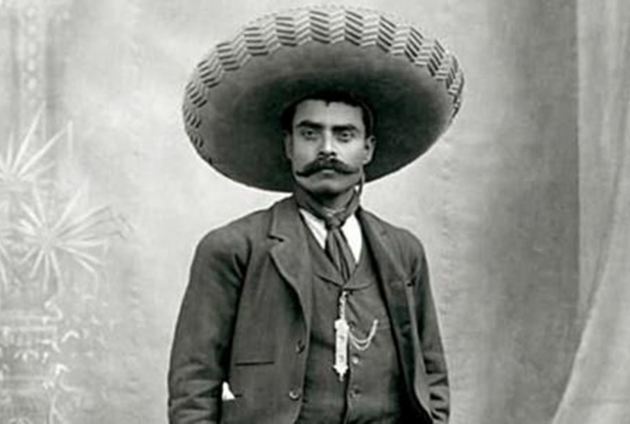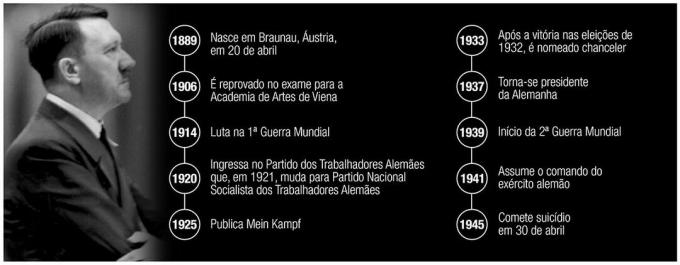Emiliano Zapata (1879-1919) was a Mexican revolutionary leader and to this day considered a hero to many in this country.
Zapata led the Mexican Revolution (1910) from southern Mexico, commanding the Libertador Army of the South against landowners who monopolized land and water resources to produce sugar cane.
He carried out the agrarian reform, returning the peasants to their lands, in a movement that is known as “Zapatismo”.
Biography of Emiliano Zapata

Emiliano Zapata Salazar was born in the rural village of San Miguel Anenecuilco (in the state of Morelos) on August 8, 1879. He was the penultimate of ten children of Gabriel Zapata and Cleopas Jertrudiz Salazar.
This family owned land, however, it was not fertile. Humble, the children only received primary education, which was a privilege, as 80% of the Mexican population was illiterate.
Even so, Zapata was a student of Emilio Vara, who in turn introduced him to anarchism by Ricardo Flores Magón (1874-1922), deeply marking his education.
Born under the government of Porfirio Díaz (1830-1915), dictator in Mexico for thirty years, Zapata grew up at a time when the country was developing its first industries.
However, Díaz would be responsible for the degradation of rural workers, allowing large farmers to take the lands of independent indigenous communities (pueblos). This increased the misery of farmers and the concentration of land in a few families.
Emiliano Zapata's own father had part of his land appropriated by one of these landowners.
In 1909, at the age of thirty, Zapata was elected “President of the Defense Board of the Lands of Anenecuilco”. In this way he became the military leader of the peasant forces in the region.
So Zapata began the campaign for the rights of peasants deprived of their land, which led to his arrest several times.
On one of his releases, he abandoned peaceful claims to farmers' titles.
He made the decision to form an army and begin armed struggle in southern Mexico when he became the general of the “Ejército Libertador del Sur” (Army Libertador del Sur).
Emiliano Zapata and the Mexican Revolution

In 1910, Zapata allies with Francisco I. Madero (1873-1913), politician who opposed Porfirio Díaz in that year's elections. However, the dictator is re-elected after a series of electoral crimes, triggering the Mexican Revolution of 1910.
Allied with the army of Pancho Villa (1878-1923), leader of the revolutionary armies in the north, Zapata led more than five thousand men. Under his leadership, they capture the cities of Cuautla and Cuernavaca, helping Madero assume the presidency.
Consequently, Madero turns out to be a fake and fails to keep his promise to return the land to the peasants.
Zapata, in turn, maintains his revolutionary ideals and launches the “Ayala Plan” in 1911, proposing “Reform, Freedom, Justice and Law”. Therefore, he implements a substantial agrarian reform in the State of Morelos, in southern Mexico.
Meanwhile, President Madero and his deputy are assassinated by General Victoriano Huerta (1850-1916), who assumes power in 1913.
However, the revolutionary armies of the north and the south are united and supported by the loyalist troops of Venustiano Carranza (1859-1920). Together they defeat Huerta's forces in July 1914.
Carranza declares himself the new revolutionary leader and summons deputies to draft a constitution. Representatives of all states and political factions, except Zapatistas and Villistas, came to the rescue.
The text is promulgated in 1917, but Zapata did not accept the new leadership and remains in arms against the new regime.
Finally, Emiliano Zapata is murdered at the age of 39, in an ambush set up by then-Colonel Jesús Guajardo (1892-1920) on April 9, 1919, in the city of Chinameca.
After his death, the Southern Liberation Army began to break up and the Zapatista movement lost its strength.
Zapatismo
Even with the death of Emiliano Zapata, his ideas remained alive and inspired several Mexican leftist political groups.
The most famous of these was the Zapatista National Liberation Army (EZLN). This was a military organization formed by indigenous people and peasants, originating in southern Mexico, in the state of Chiapas.
This movement became famous around the world on January 1, 1994 when it occupied several Mexican cities. They also demanded from the government respect for the indigenous people, extinction of the Free Trade Agreement with the United States and Canada, and an end to corruption.
Likewise, one of the EZLN's banners was agrarian reform, the same ideal for which Emiliano Zapata had fought and which inspired these guerrillas.
Phrases by Emiliano Zapata
- "It's better to die on your feet than live on your knees."
- "A strong people doesn't need a strong leader."
- "If there is no justice for the people, let there be no peace for the government."
- "I want to die as a slave to principles, not men."
- "The land is for those who work it."
- "I forgive the one who steals and the one who kills, but the one who betrays, never."
Curiosities about Emiliano Zapata
- Emiliano Zapata had the reputation of being vain and always well dressed.
- The leader of the Mexican Revolution would be immortalized in several paintings by the painter Diego Rivera.
- Zapata was a mestizo of Nahua and Spanish descent.
- It is said that Zapata made the decision to fight for the rights of the peasants when he saw his father cry when he was dispossessed of part of his land.



